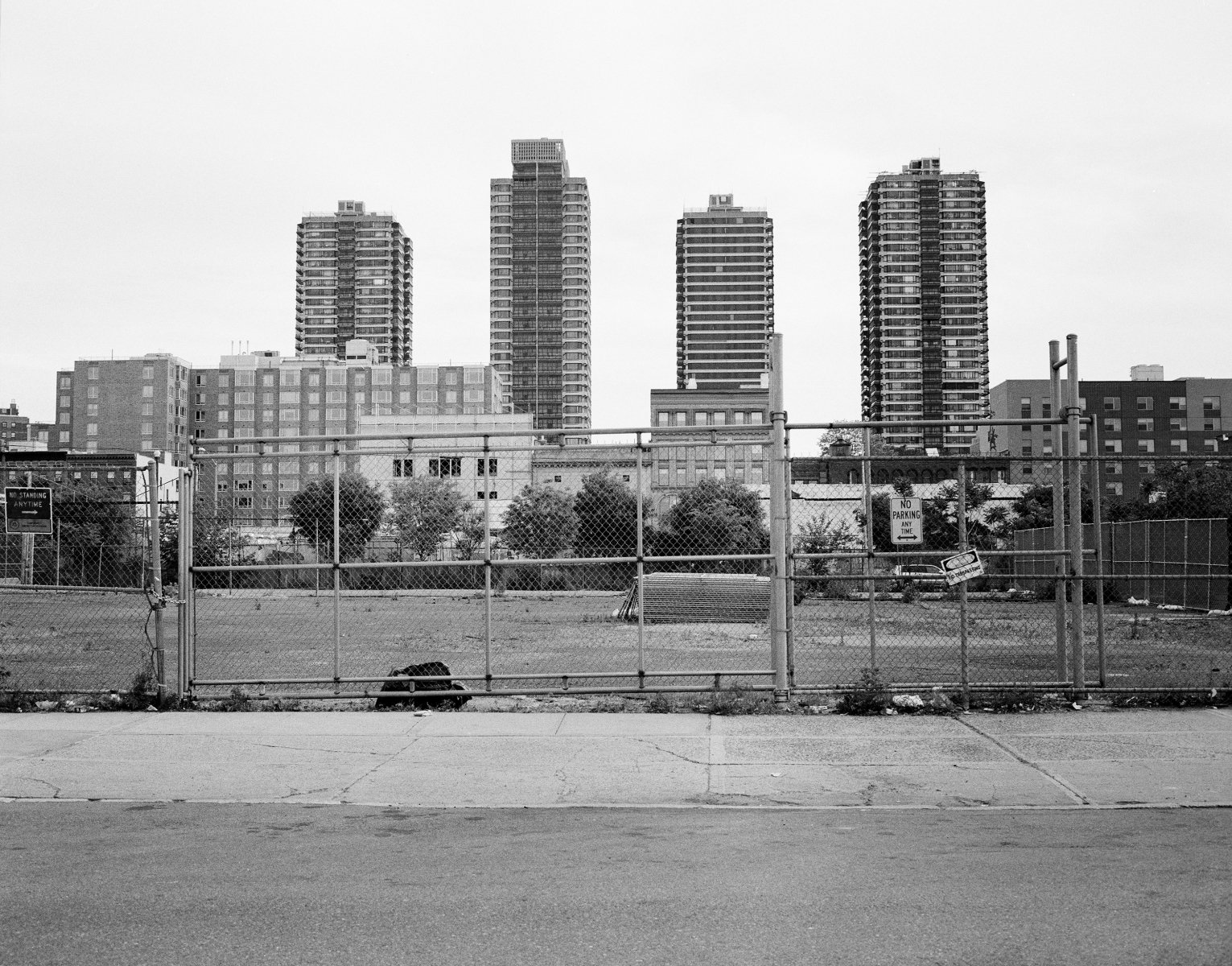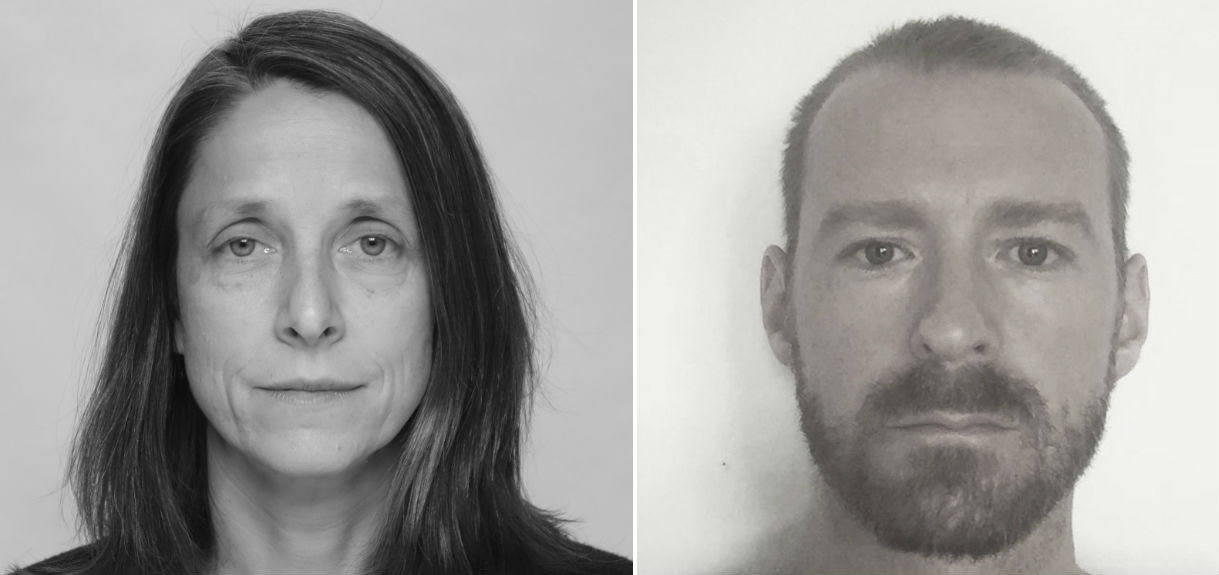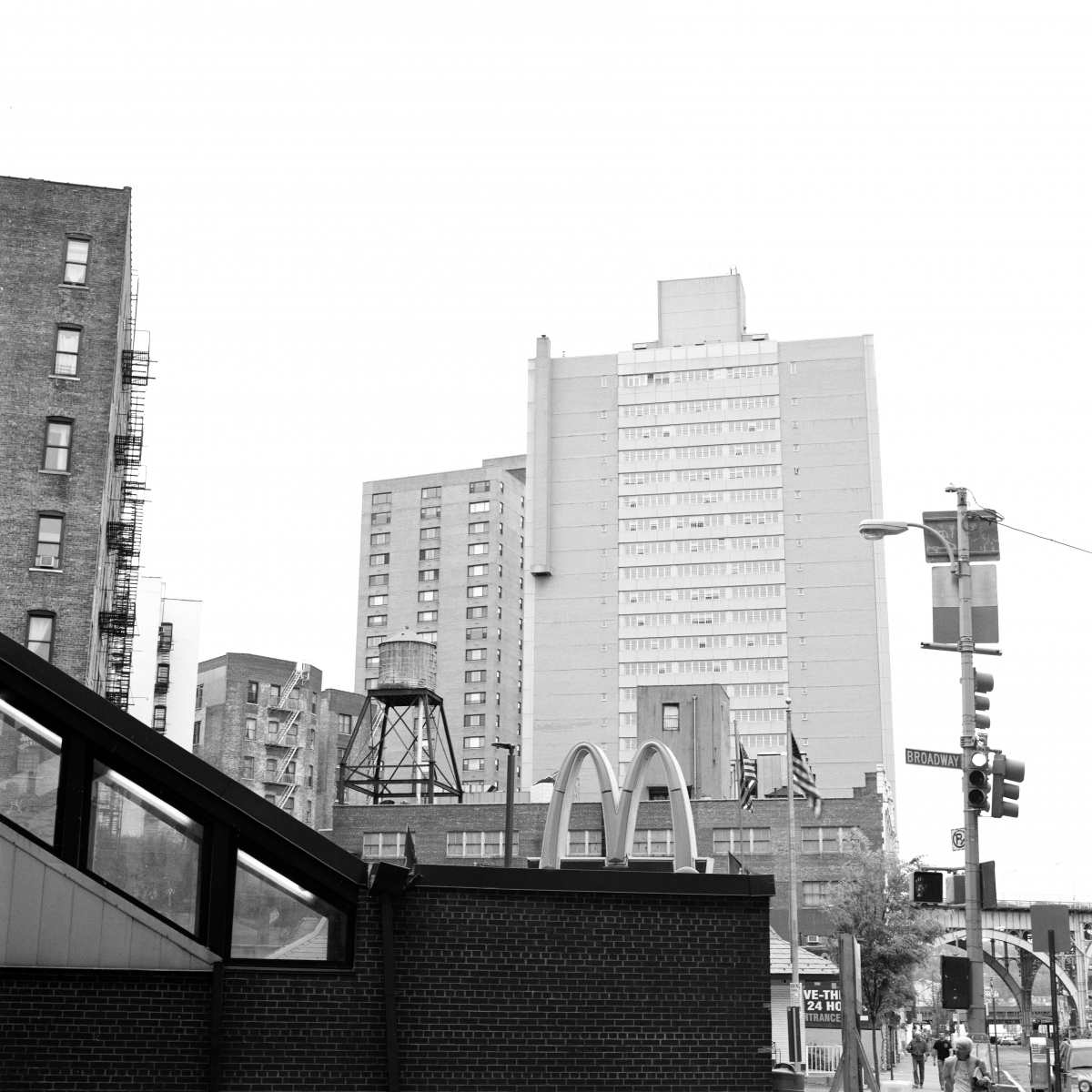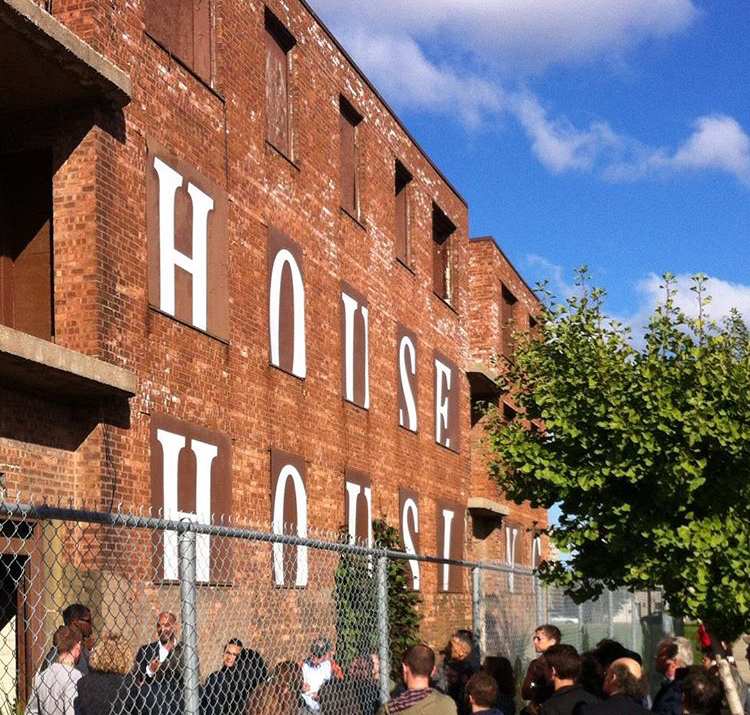
November 25, 2015
Affordability Won’t Solve Housing Crisis. Public Housing Will
The editors of a new report on architecture and real estate discuss why affordability isn’t the solution to the housing crisis.

The editors commissioned two photographers, Emily Kloppenburg and Ilaria Ortensi, whose photographs supplement the report and frame “the ever present… seemingly self-evident faces of inequality” in New York.
Courtesy Ilaria Ortensi
The American housing crisis is getting worse. The problem is not affordability, as most building developers would argue, but inequality, says a new report titled The Art of Inequality: Architecture, Housing, and Real Estate, produced by the Temple Hoyne Buell Center for the Study of American Architecture at Columbia University. Jacob Moore and Susanne Schindler, who edited the report along with Buell director Reinhold Martin, spoke to Metropolis editor Samuel Medina about architecture’s role in abetting inequality and the urgent need to revive the issue of public housing.
Samuel Medina: Can you explain the beginnings of the project?
Jacob Moore: When I came on at the beginning of 2013, the Buell Center was finishing up the last part of Foreclosed: Rehousing the American Dream, more specifically, “Comments on Foreclosed,” which was an attempt to digitally map out all the public commentary that surrounded the exhibition’s stay at MoMA. I helped wrap that up, but as an institution, the Buell Center was already very embedded in housing as a subject of research. We’re almost two and a half years into the House Housing: An Untimely History of Architecture and Real Estate initiative (of which The Art of Inequality is a result), which draws on a large body of research about housing and real estate in the attempt to locate architecture’s role therein. Despite my involvement in this study, I should say that I’m no expert on housing—those of us at Buell try to make that clear in all our projects. But Susanne has a very different background vis-à-vis housing.
Susanne Schindler: I’ve been involved at Buell since the summer of 2013. I’m an architect by training and I’ve always been interested in the ways that design and policy do and don’t interact in housing. Although I’ve worked as a researcher, curator, and editor on House Housing and The Art of Inequality report, I come to all of this from a design perspective. I think housing is one of the most fascinating design challenges, independently of whether it’s called “market-rate,” “affordable,” or “public” housing.
SM: How so is the new report an extension of the Foreclosed project and, even earlier, the Buell Hypothesis, which provided part of the conceptual basis for the former?
JM: For the Foreclosed exhibition proper, there was a roundtable convened at MoMA by developers to talk about the projects that were part of the show, and their actual viability, which, of course, was never the point of the exhibition but nevertheless that was one of the ways that it was digested. Anyway, at that roundtable there was a real estate lawyer from Arizona, I believe, who said, “In my America, none of this is ever going to be possible.” He was angry that the projects had assumed a certain possibility for realization. That was striking for several reasons, not least because it was someone from real estate saying that. It was becoming clear to us, especially with the reaction to Foreclosed, that real estate development was driving what could and couldn’t be said about architecture and urbanism today, much less made. Because this was a reaction to a project that we had formulated, we hoped very much that in the next project we would make it harder not to address these issues—we would address them ourselves while also creating a situation where it is almost impossible to ignore them in the discourse that follows. That’s what we did with the The Art of Inequality report, we are forcing the issue of housing as a public good—public housing, even—which cannot be openly discussed anymore.
SM: Jacob, you said you’re not an expert on housing, which begs the question of the “provisional” in the second part of the book title. What was the intention behind appropriating the format of a report as an instrument?
SS: I think you have to take the “provisional” together with the “report”—the latter assumes an authoritative document at the end of a long period of data collection, which we didn’t do. We tried to synthesize and interpret existing research. There was a basic task of coming to terms to how inequality is defined and what role housing plays in it. The project then had to draw on the existing research and connect the dots. So “provisional” is a disclaimer, but it also points to the fact that a lot more work needs to be done on the subject.
JM: The report genre was something that we had thought about for a long time, and coming right off of Foreclosed, we had been thinking about what new formats and ways we could use to give more urgency to the issues we were planning to talk about. The 1968 Kerner Report was one part of the broader House Housing exhibition research that we were doing at the time. It was the result of a government commission with a large, full-time staff working on fact-finding for a year to put together a report that then went through countless drafts. So, on the surface of things, we had to account for the fact that The Art of Inequality was the effort of three editors and six to eight students conducting research for less than a year. It’s substantial, and thought we took it very seriously, it certainly not on the scale of the Kerner Report.

“We tried combating any polemical discussion about inequality and housing,” says Jacob Moore (right), Buell Center program coordinator and editor, along with architect Susanne Schindler (left) and professor Reinhold Martin, of The Art of Inequality report.
Courtesy (left) Susanne Schindler and (right) Jacob Moore
SM: But the structure of your report somewhat follows that of the Kerner Report, right?
JM: It’s not a one-to-one fit, but it does follow the questions that were at the basis of what was officially called the Report of the National Commission on Civil Disorders. With his Great Society as a backdrop to the race riots throughout the country, President Johnson put together a commission, and his charge to it was summarized in three questions: (1) What happened? (2) Why did it happen? (3) What can be done? We did plenty of precedent research into the report genre, but this formula proved useful in its simplicity, and so we updated the questions in the present tense: (1) What is happening? (2) Why is it happening? and (3) How is it happening? We wanted to avoid the question “What can be done?” because it leads to seemingly definitive prescriptive solutions. So in our report, with the first question, Susanne and I are trying to describe inequality as it’s understood in different ways, while teasing out how architecture can find ways into this discussion. With the second, Reinhold [Martin] expands on these themes, but flips the script in order to have inequality do some of the heavy lifting; that is, inequality is the subject, not the object and so it isn’t just the result of other forces, but is itself a force. Part three—the “how”—is much more discreet, and it’s where our graduate student collaborators describe the many different tools of inequality, from textbooks to renderings to contracts.
SM: Inequality is a term that can be difficult to pin down as there doesn’t seem to be a consensus to what it means or entails. Why did you choose inequality as the anchoring for your exploration of housing?
SS: Well, the short answer is that everyone is talking about inequality. It’s on everyone’s mind.
JM: I would also say that it revealed itself to us in the course of our research, just like the issue of real estate revealed itself as a useful umbrella term when we were working through the House Housing exhibition. I think something similar happened with our exploration of inequality. Unlike, real estate, which is discussed openly in the public but remains somewhat obscured, inequality is something that is “named”—you have Joseph Stiglitz’s “1%” to which Occupy responded with the “99%.” But it’s a far more complex issue than that, and so, while everyone is talking about it, nobody is talking about the same thing.
SM: You write in the report that “architecture makes real estate real,” which is a neat tautology, but what about architecture makes it an interesting and useful framework for working through concepts and problems of inequality?
SS: The purpose of the report is to contribute to the discussion of inequality, which encompasses race, income, segregation, and gentrification, among many more things, from a specifically architectural perspective. But it’s difficult to put your finger on what architecture actually has to do with socio-economic issues. Sure, you can say that architecture gives shape to wealth, as is the case with the glossy high-rise condo tower; you can just as easily look at brick housing blocks in the Bronx and see how they give expression to how society thinks lower-income households should live. But that’s too easy. When we say that architecture makes real estate real, we are making the assumption that without architecture real estate simply can’t happen.
JM: In a similar way, the report shows how inequality, too, is designed, and we, as architects, are part of that design process. We use architecture to show that there is agency in the production and reproduction of inequality.
SS: It’s also where we’re coming from. We’re based at a school of architecture and are producing a report on housing. It was astonishing to us to find just how much research is being done by sociologists, anthropologists, geographers, economists—there is just so much work on inequality.
JM: The same can be said about housing. One of the most interesting parts of this project for me was just discovering how far-reaching that field called “housing” is, and how, weirdly, architecture actually isn’t embedded in a lot of the discourse.
SM: In Europe, you have the term “social housing,” which, to the North American ear, reeks of negative connotations. At the same time, “public housing” itself is taboo—it’s simply not on the table in American cities anymore. How did you try to clarify the meaning of these loaded terms?
SS: The broader project is called House Housing precisely because both terms, in reality, are about the same thing—a house is just one form of housing. We wanted to play with existing stereotypes about types, while at the same time, not falling into that trap and reinforcing them: for instance, the notion that housing is associated with subsidies, while a single-family house isn’t. The broader project seeks to explain how things work: how do design, finance, and policy actually influence and condition each other? Our associations are often wrong. Single-family houses in the suburbs, for instance, are actually heavily subsidized. The mortgage-interest deduction is a non-needs based subsidy administered in the form of a tax deduction that largely benefits middle- to upper-income households, not the poor who don’t make enough to take advantage of the deduction. Another example are tax abatements such as New York 421-a program, which has largely resulted in luxury developments. As the Center for Urban Pedagogy has succinctly put it: All affordable housing is subsidized, but not all subsidized housing is affordable.
JM: We learned from our previous experiences with Foreclosed that you can’t just will the conversation to happen on your terms. That’s part of the reason for our using inequality as a headliner. We tried combating any polemical discussion about inequality and housing by boiling everything down to facts, little digestible bits of information that the reader will recognize as being facts rather than ideology or argument. That’s another lesson we learned from “Comments”—if you’re polemical in any predictable way, you’re going to get predictably polarized responses, and that’s going to be that. Instead, we tried going at it in a granular way, and present information that on the face of it isn’t surprising or crazy, but only in its digestion, reveals itself to be a little thornier.

Ortensi and Kloppenburg, who shot this streetscape, photographed the East–West span of 125th Street.
Courtesy Emily Kloppenburg
SM: But it’s more pointed than just, say, a data dump.
JM: Definitely, but at the same time, there’s no “Architecture and Capitalism” headliner, either.
SM: There’s this notion that architects shouldn’t be designing public or even low-income housing but that they should be putting their efforts toward “designing” the legislation that underwrites inhabitation. Is that something that you’re suggesting? What does that even look like? It seems that architects have trouble working out how to apply their skills to the field of housing.
JM: We really tried not to give a clear outline for intervention. We are, however, saying that architecture does have a place in discussions of housing, both in policy and in construction, and so architects should understand architecture’s role in these matters. The ultimate aim is that architects feel like they can use this information to go do something, but again we didn’t want to sanction any specific solutions. Having an impact on legislation is one very clear, possible outcome of an architect’s involvement in issues of housing, and we say as much when we show in the report that taking political action—however you want to understand politics—is inevitable as an architect. It’s up to each architect to be more or less assertive about that agency.
SS: It’s funny because this was the first question that was asked when we launched the report at the Goethe-Institut [in New York] a few weeks ago, and we anticipated it. It was an architect asking us what can be done with this information. In response, we explained that we tried to stay away from solutions. I did, however, give my personal opinion.
SM: Which is?
SS: I’m a big advocate of cooperative housing that stays non-profit in perpetuity. In Europe, cooperatives were originally founded to exist outside the market, and that is how they continue to function there. In the United States, this vision has always only half-heartedly been embraced. I would suggest reinventing the Mitchell–Lama Housing Program [the 1955 New York State program for limited-dividend rental and cooperative development] on a large scale, with the important change that owners cannot “opt out” of the program and “go market rate” once their mortgage has been paid. In addition, I would tie the public subsidies to design competitions to further the quality of the architecture.
JM: That would do a lot of good, as would putting public housing back on the table. But the rush to talk about solutions assumes that we’re all talking about the same problem. Or that we all share the same understanding of the problem. That is almost categorically inaccurate, especially in such politically sensitive discussions. So the point is to come to a consensus about the situation at hand, and perhaps, at another venue, we can discuss solutions.
SM: How would you like to see this research being integrated into schools of architecture?
JM: Before we even did the report, we put a bibliography up on the House Housing website. One potential challenge that any architecture school could take up would be to figure out what a course on architecture and real estate would look like. I would say that it’s a victory if we’re getting studio students to look into that bibliography and getting to the point where they’re reading policy briefs—not solely policy briefs but coupled with, say, some cultural criticism, among other things.
SS: I taught a housing studio at Columbia last fall. One of the things I asked the students to do was to challenge the HPD [NYC Department of Housing Preservation and Development] design guidelines, but it wasn’t very productive because none of them had any experience designing housing. And so they didn’t feel any urgency to challenge regulations on dimensions or occupancy or program because they’ve never worked with these constraints, haven’t been subject to a developer, or an agency, telling you your design is illegal or too expensive. But it’s only then, in that moment of designing, that you might realize that you need to work not just within the system, but also that you might have to jigger with it. Many students, just as many architects, expect to be told what to do, expect to be given a brief to respond to. The goal with our publication is to suggest that you need to dig deeper. A brief is never just a brief—somebody wrote it with certain intentions in mind, with a certain pro forma behind it, and a certain policy goal. It’s not just solving the question that someone else has asked, but questioning the question.
SM: It’s more than, say, designing a house for X amount of dollars, full stop. What do you make of Mayor Bill de Blasio’s housing plan that was released last year and which has come under criticism from both sides of the political spectrum?
SS: Very early on, when he released his plan, de Blasio said that his administration is going to negotiate harder, but that the tools they’re going to use are exactly the same as Bloomberg’s. And those tools all rely on the private real estate market to do the job. But given New York City’s unique situation in terms of demographic and economic growth, why aren’t we talking about public housing? It doesn’t have to be the same federally funded program we’ve known since the 1930s, which, by the way, has never had the political and financial support that it would have needed to succeed. So why not start a municipal public housing program, since we’re so generously subsidizing very profitable affordable housing development? Why not consider a permanently non-profit as well as a public option?
The initial House Housing: An Untimely History of Architecture and Real Estate exhibition debuted in Venice in 2014.
SM: You launched the second iteration of House Housing exhibition at the Chicago Architecture Biennial, nearly a year and a half after it was launched in Venice. How has it been recalibrated to fit its new setting?
JM: The collaboration in Chicago came about when we went looking for partners to work with in producing something for the biennial. We had been in touch with the National Public Housing Museum (NHPM), in Chicago for some time about potential collaborations, and the biennial gave us the chance to work with their curator and associate director Todd Palmer. The structure of the show itself is similar to Venice in that it revolves around a number of short “episodes”—in Venice there were 19 episodes, and there are 23 in Chicago.
SS: Chicago has a very particular historic context in terms of housing. Partnering with the NPHM, which grew out of that context, aided both institutions to expand the conversation about housing as a public good. It was also a great venue that we were able to work with. It is the last remaining building of the 1930s Jane Addams Homes which were otherwise demolished as part of the HOPE VI program. The building has been unlived in for more than 12 years, still is surrounded by vacant land, and, accordingly, has a very haunting presence. Also, the NPHM is running a youth program called “We, Next Door” with current and returning residents of public housing. They took House Housing as a prompt for these teenagers to think about the broader forces that shape housing, and they produced their own video pieces in response which are part of the Chicago exhibition.

Moore and Schindler worked with the National Public Housing Museum on the latest iteration of the House Housing exhibition.
Courtesy Pedro Gonçalves
SM: Can you give an overview of the episodes format?
SS: The original idea to use a short, anecdotal “episode” as a format to explain the relationships between policy, finance, and design in housing, came from a 1932 news clipping about Frank Lloyd Wright that told of how a series of houses he designed in Michigan were denied Federal Housing Administration (FHA)-insured mortgages because they were considered too high-risk. There’s a nice contemporaneous article in the Chicago Tribune included in the exhibition that lists the reasons why—poor construction, flat roofs, the lack of division between public and private, no basement, etc. It ends with the resale value of those houses being in doubt. A member of our research team found correspondence between Frank Lloyd Wright, the FHA in Washington, and the client running back and forth trying to convince the other that the houses should be insured. Ultimately, they were not insured, but basically the story is that Frank Lloyd Wright’s architecture is a bad investment. Of course, we used Frank Lloyd Wright—because if there is any architect that is known by non-architects, it’s him or the other Frank, Frank Gehry—as a way to tie that to a discussion of the design guidelines that the federal government had put in place, which became the underwriting guidelines for banks, which became the design guidelines for builders. The form of this short episode proved to be an effective way to illustrate how the policy, finance, and design are intimately linked. So we determined that each episode had to be very concise—150 words—have a newspaper tagline to bring the story home, and be supported by three to four multimedia artifacts. That’s the original episode, and we tried to spread the subsequent ones across the last hundred years.
JM: Translating that to Chicago, we wanted the material to speak through the space. It was a very particular design challenge because the museum is based in what is essentially a ruin, so there was no real material in the space. The space itself is very powerful and something that we wanted to respect without fetishizing, especially for an architecture audience who we knew would come and just ogle the space. We couldn’t touch the walls so we did a very sparse installation using modular off-the-shelf furniture that people wouldn’t think twice about. We wanted something that felt at home in that space and could have very well fit into that apartment, when it was lived in less than a decade ago, while also suggesting that these spaces could be lived in again. The material, like in Venice, is a multimedia presentation—radios playing audio snippets, televisions showing marketing videos, slide projectors with subdivision plans, etc. We try to make each installation into what we’ve called a “whispering, humming history machine.”

Inside the Chicago exhibition at the National Public Housing Museum
Recent Viewpoints
Viewpoints
Navigating the Path to Net Zero





